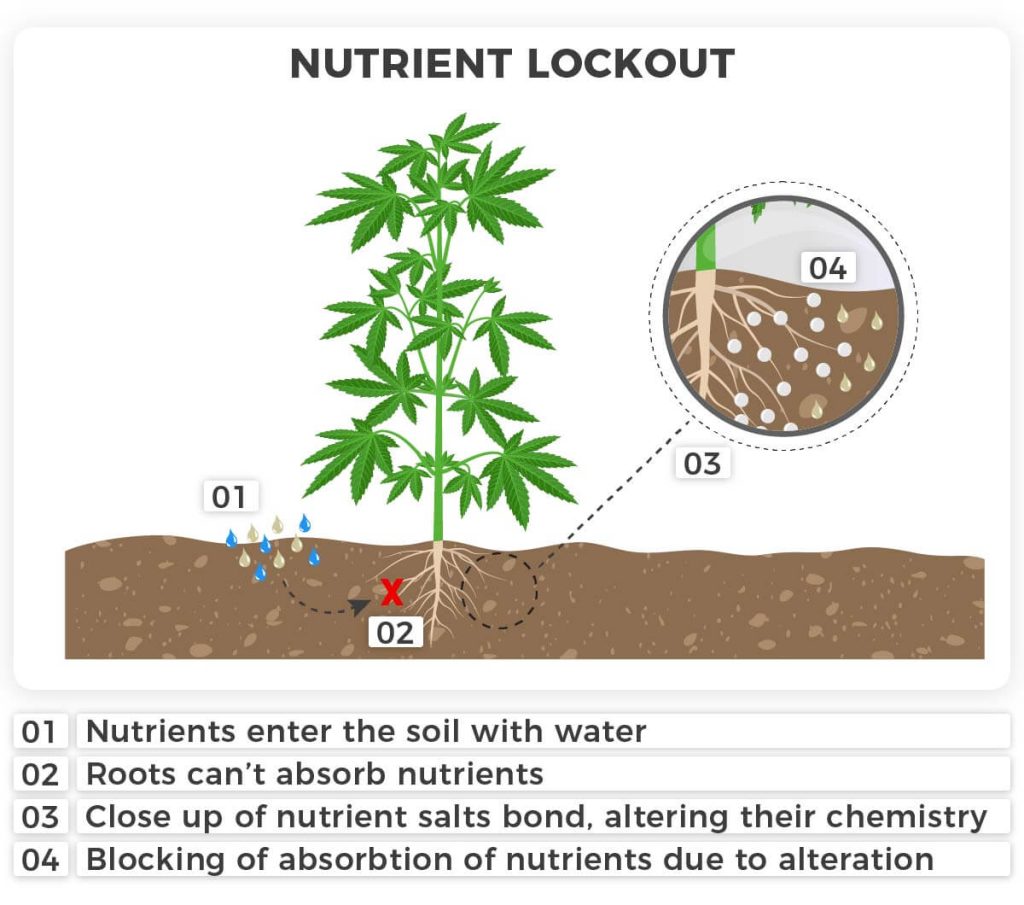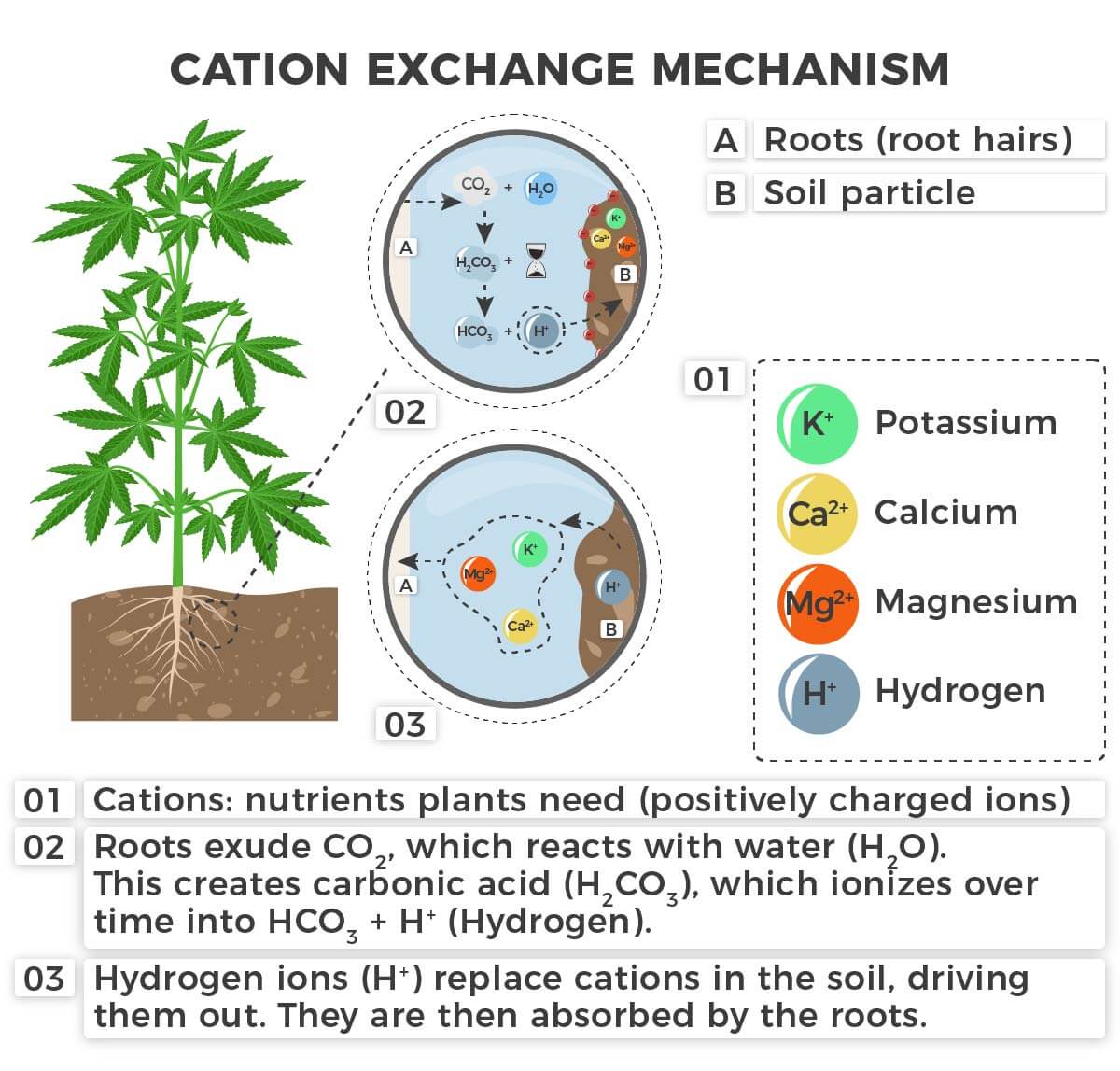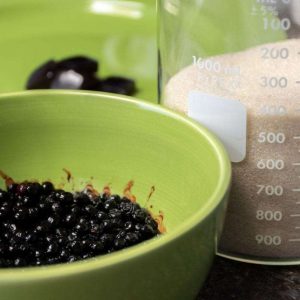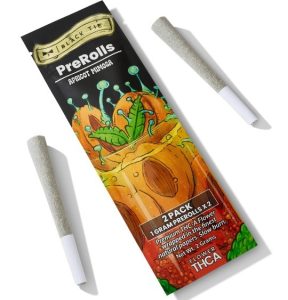How to Prevent and Treat Nutrient Lockout in Cannabis

Nutrient lockout is a fairly common problem in indoor cannabis cultivation due to the use of fertilizers containing nutrient salts. Excess nutrient salts can accumulate in the growing medium, leading to fluctuations in pH, nutrient levels, and nutrient availability.
When this occurs, a plant cannot absorb the necessary nutrients from its growing medium. The resulting nutrient deficiencies will severely hinder plant growth and development. It can even result in plant death.
Thus, Growers must temporarily stop plant feeding in favor of flushing out the medium to restore balance. However, this can slow overall growth and cause further delays in plant development.
Let’s explore the concept of nutrient lockout, its causes, symptoms, remedies, and preventive measures that can help growers avoid this common mistake, not make it worse!
What is nutrient lockout?
Nutrient lockout refers to a condition where cannabis plants cannot uptake and absorb the essential nutrients for healthy plant growth from the growing medium despite nutrients being present.
This condition happens when excessive nutrient salt residues accumulate in the growing medium, creating imbalances and disruptions in the pH levels and/or nutrient ratios within the root zone, hindering the plant’s ability to absorb them.
Nutrient salts bond with soil particles and other salts, which slightly alters their chemistry and locks them out, making them unavailable to plant roots. As the locked-out nutrients fail to enter the plant’s vascular system, the plant begins to starve while surrounded by food it can’t access.
What is the difference between ‘lockout’ and nutrient burn?
While nutrient lockout and nutrient burn are often confused, they are two distinct conditions. Nutrient burn occurs when plants are exposed to excessive levels of nutrients, resulting in burnt or scorched leaf tissue. This excess may result from improperly composted “hot” soils or excessive liquid fertilizer applications, especially on young plants.
On the other hand, nutrient lockout occurs when the plant cannot absorb the available nutrients in the growing medium because accumulated salt residue from prolonged nutrient use has made them unavailable. Nutrient lockout can lead to deficiencies that often look similar to nutrient burn.
What causes nutrient lockout?
Nutrient lockout can be caused by several factors, such as incorrect soil or nutrient solution pH levels, imbalanced nutrient ratios, low-quality water/improper watering practices, and soil compaction.
Generally, the single biggest reason for nutrient lockout is the presence of excess nutrient salts in the growing medium from the use of fertilizers. Over time, these excess salts will raise or lower pH levels in the medium away from the optimum levels desired by plant roots.
As plants have an optimum pH range for nutrient absorption between 5.5 (hydroponics/soilless) and 6.5 pH (soil/organics), fluctuations caused by these excessive salts can raise or lower pH levels outside of that optimum range, making most nutrient elements unavailable to the plant.
A growing medium can only hold a specific amount of nutrient salt particles relative to its electrical charge. Negatively charged (-) clay particles, for example, can attract the most cations (+) (positively charged particles) (pronounced cat ions) from nutrient solutions. This concept is known as CEC (Cation Exchange Capacity).
Visit the ilgm grow guide to learn more about the specifics of water & nutrients and take your growing skills to a higher level.
Nutrient lockout’s inner workings: What’s happening inside the plant?
Nutrient lockout disrupts the ion exchange process that occurs within the root zone. Plant roots release hydrogen ions (H+) to exchange with and absorb essential nutrients from the growing medium. However, when pH levels are too high or too low, this exchange is hindered, preventing the plant from accessing the required nutrients.
As a result, the plant is starved of the elements it needs to perform the metabolic functions that support optimal growth. The plant will begin showing symptoms, such as discoloration (chlorosis) of leaf tissue, limp leaves, and slowed or stunted growth.
Nutrient lockout can progress to the starvation death of leaf tissue (necrosis).

Can overwatering cause nutrient lockout?
Yes, overwatering can contribute to nutrient lockout. The excess moisture displaces oxygen from the root zone, leading to anaerobic conditions and root rot. Killing off roots will reduce a plant’s ability to absorb necessary nutrients in the soil, allowing excess salts to accumulate there, making the problem worse.
The lack of oxygen also kills off the beneficial bacteria in the soil, which help to break down nutrient salts so that plant roots can absorb them.
Overwatering kills more cannabis plants (and housepants) than any other reason. Why? Because we are faulty humans, and our nature allows us to overdo things.

Can hard water cause nutrient lockout?
Hard water, which contains high levels of dissolved minerals like calcium and magnesium, can contribute to nutrient lockout. The excess minerals in hard water can raise the pH levels of the soil or growing medium above the optimum range, affecting nutrient availability to the plant. Using a water filtration system or distilled water can help prevent nutrient lockout caused by hard water.
How do I know if my plant has nutrient lockout?
Plants experiencing nutrient lockout display various symptoms. Common signs include yellowing or browning of leaves, stunted growth, limited new growth, and overall poor plant health. Additionally, pH testing of the runoff water and nutrient deficiency tests can help identify nutrient lockout.

How do I fix nutrient lockout?
Take these steps to fix nutrient lockout:
Step 1: Identify the symptoms affecting your plants. Are they caused by nutrient lockout? If that’s the case, then…
Step 2: Stop fertilizing the affected plant(s). Prepare a flushing solution of balanced water using pH-up or pH-down solution mixed into irrigation water.
Step 3: Flushing the plant with a pH-balanced solution helps remove excess salts and restore proper nutrient uptake. Be sure to use enough solution to achieve runoff (allowing excess solution to drain out of the plant), as this will reduce salt buildup.
Step 4: Measure the nutrient strength and pH of the runoff water and adjust the nutrient solution’s strength and pH composition to suit the plant’s needs if necessary.
How do I flush a nutrient lockout, and how long do I flush?
Flushing involves watering plants with a large volume of pH-balanced water to flush out excess salts and restore nutrient uptake. The duration of the flush depends on the severity of the nutrient lockout and growing medium, usually lasting anywhere from a few days to a week.
It is essential to monitor the pH levels and salt content of the runoff water during the flush to ensure proper removal of excess salts. Using a TDS device (total dissolved solids) to measure salt content and a pH meter will make this task much easier and more precise.
Will my cannabis plants recover from nutrient lockout?
With proper care and intervention, cannabis plants can recover from nutrient lockout. Adjusting the pH levels, flushing the growing medium, and gradually providing the necessary nutrients will help restore the plant’s health. However, it is important to note that the recovery time may vary depending on the severity of the lockout and the plant’s overall condition.
How do I prevent nutrient lockout?
Preventing nutrient lockout involves maintaining optimal pH levels in the growing medium, using properly balanced nutrient solutions, and practicing proper watering techniques. Regular pH testing and monitoring and periodic flushes can help prevent nutrient imbalances and lockout. Additionally, using high-quality water and avoiding overfeeding can contribute to preventing nutrient lockout.

Bergman’s Plant Protector
- Protect your plants from diseases and harmful pests.
- Consists of three 20 ml bottles
- Enough plant protection system supplies for up to 20 plants
- Suitable for soil, hydroponic and all other grow mediums
Final thoughts on nutrient lockout
Nutrient lockout is a common issue faced by many indoor cannabis cultivators and is largely the result of inexperience in the garden. It’s human nature to think that “more is better,” and this reasoning leads to excessive fertilization.
As we learn by doing, nearly every gardener will overdo it with fertilizers at least once and damage their plants somehow. Cannabis plants don’t need to be fertilized every day. If you ate constantly, you would get fat and sick!
Understanding the causes, symptoms, remedies, and preventive measures for nutrient lockout is essential for successful and healthy plant growth.
Maintaining proper pH levels, providing balanced nutrient solutions, and practicing good watering, feeding, and flushing techniques can help growers minimize the occurrence of nutrient lockout and maximize the potential of their cannabis plants.
A good rule of thumb is to fertilize with plain water for a day after every 2 to 3 days of macro feeding or to reduce the amount of macro fertilizer used by ⅓ if you’re going to fertilize more often.
Used sources for this article
- Llewellyn, D. J., Golem, S., Jones, A. M. P., & Zheng, Y. (2023). Foliar Symptomology, Nutrient Content, Yield, and Secondary Metabolite Variability of Cannabis Grown Hydroponically with Different Single-Element Nutrient Deficiencies. Plants, 12(3), 422. https://doi.org/10.3390/plants12030422
- Bamsey, M., Graham, T., Thompson, C., Berinstain, A., Scott, A. B., & Dixon, M. (2012). Ion-Specific nutrient management in closed systems: The necessity for Ion-Selective sensors in terrestrial and Space-Based agriculture and water management systems. Sensors, 12(10), 13349–13392. https://doi.org/10.3390/s121013349



